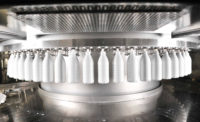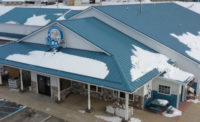
The Big Chill
Wells’ Dairy’s South Ice Cream Plant dominates the worldof frozen dessert production.
Record-keepers at
Wells’ Dairy Inc. say it takes 75,000 cows to produce the milk needed
every day by the company’s three plants in Le Mars, Iowa. It’s
a cinch that most of that goes to the South Ice Cream Plant, purported to
be the largest free-standing ice cream manufacturing plant in the world.
In fact, three large dairy farms in northwest Iowa
commit their total output to Wells, with additional milk coming from as far
away as California and New Mexico, says Bruce Noorgaard, lab technician and
33-year company veteran. It’s a long way from the cornfield that
occupied this site about a dozen years ago.
The plant’s receiving area can hold eight semi
tanker trucks at once. All milk is sampled and must pass lab testing before
it’s offloaded and processed in one of four systems to create the mix
needed to make a bewildering array of Blue Bunny-branded packaged ice cream
and frozen novelties, along with contract-packed goods.
Novel Ideas
It seems like the action never stops at the South
plant, and in a way, that’s true. Ice cream moves to each line in a
constant flow, each square, round, cup or bar just barely ahead of the
next. Company officials won’t reveal exact figures for the capacity
of each line, but to see them in operation, it must be considerable. More
than 200 mixes are used to create all the products made here, with most
lines under computer control.
Take one of the plant’s extruded stick novelty
lines, for example. Ice cream is fed to the bar former from above,
the frozen stream cut by a wire to the proper size as a wooden stick is
inserted before the bar drops onto on conveyor, followed close behind by
its thousands of cousins on their way to be wrapped and boxed.
The plant’s newest novelty production line,
installed two years ago, makes extruded bars and features the latest in
robotic technology. Formed bars laid three across ride the conveyor belt
into a spiral hardener. Bars exiting this blast freezer are snatched up by
a robotic arm and placed on the wrapping line. Wrapped bars then are
grabbed by another robot and packed into boxes, which are robotically
packed into cases.
Other stick novelties are made on one of the
plant’s 18-wide fillers that accept a variety of molds for making a
wide assortment of bars and pops, including Blue Bunny’s popular
tri-color Bomb Pop. To make these colorful treats, each of three flavors is
added one at a time, then allowed to set up so the stick can be inserted
before final freezing.
A more recent addition to the Blue Bunny product lineup
that runs on this line is the no-sugar-added Sweet Freedom White Chocolate
Almond Lites. The bars are formed from vanilla-flavored frozen dairy
dessert. After the stick is inserted and the bars set up, they’re
lifted from their molds and dipped into a bath of white chocolate with
almond pieces. Finished bars are wrapped, sorted, boxed, date-stamped,
weighed and run through a metal detector on their way to the freezer.
Another 18-wide filler runs chocolate fudge bars. The
formed bars are dipped into a water bath before wrapping. “It makes
the texture and flavor better in the customer’s freezer,”
Noorgaard explains, noting that water used for the dip is run through a
charcoal filter before use.
Meanwhile, other novelty lines run ice cream, sherbet
or sundaes in foam cups. Sundae cups are filled, two each of chocolate and
strawberry on the same line to create variety packs containing a 12-cup
assortment. A fudge or strawberry revel is fed into the stream of vanilla
ice cream at the point of filling. Fruit revels are made at Wells’
Dairy’s own milk plant in Le Mars.
Moving on to the cone novelty line, Noorgaard explains
the chocolate sauce sprayed into each cone. “We put a barrier in
every cone we make,” he says. “It keeps the cone from absorbing
moisture from the ice cream.”
Sprayed cones travel eight wide on the two cone
fillers. They’re filled with vanilla ice cream, then pass through a
hardening tunnel. Cones leave the tunnel upside down and are dipped in
chocolate, then rolled in nuts, with a foam ball used to help form a
rounded dome atop each cone, Noorgaard says. Finished cones slide down a
ramp into a sheet of wrappers, which are each cut and sealed before boxing.
Rounding out the novelty operation are the sandwich
lines, as well as lines that run “face bars” —
Disney-themed character novelties, among others — on fillers that use
molds with separate wells for each color and facial feature depicted in
frozen-dessert form. An air-injection system puts gumball eyes on each
face, Noorgaard notes.
All products eventually wind up in the plant’s
12-story freezer, where more that 52,000 pallets of product can be held at
–20 degrees F.
Package Deals
“Here again, the ice cream never stops,”
Noorgaard remarks of the constant flow to the packaged ice cream lines.
Round cartons are fed to the filler lines from the
carton-forming room, where two can formers create the cylinders from flat
stock. Fed into a carousel filler, cartons are filled from above with a
constant stream of ice cream that’s cut by a wire a split second
before the filled carton moves ahead for lidding and a new empty carton
advances to take its place.
Filled, lidded rounds are individually wrapped in film,
then shrink wrapped in bundles of six for hardening. After hardening, the
six-packs are broken into bundles of three for storage and shipping. A
paper UPC code label is applied to each six-packs, which assists in product
tracking based on date of manufacture, batch and other data.
On the squares line, flat carton stock is spread open
and filled from above, a wire again cutting the constant flow of ice cream.
The ends of the filled cartons are sealed before the squares are weighed
and metal detected. Sealed squares are guided through a diverger into a
film wrapper and shrink tunnel, where they spend just enough time to affix
the wrapper but not enough to melt the product.
A conveyor belt takes squares to the hardener. Packaged
flavors are run in a specific sequence based on the nut and egg allergen
content of each flavor, Noorgaard explains.
Tanks, located on the plant’s upper level,
contain the blended mixes needed to create all the products manufactured at
the South plant. Ice cream mix is blended on the lower level, then pumped
into the tanks upstairs until it is needed. “These tanks are situated
above or near the lines they serve, so mix doesn’t have to travel
far,” Noorgaard says. The system is constructed so mix can be
transferred to or from almost anywhere within the plan, he says.
Nuts and Bolts
All machinery, including pipes and fruit feeders, is
completely washed between runs. Machinery and parts are date-tagged after
cleaning; if they’re not re-used within three days, they must be
disassembled and cleaned again, Noorgaard says. “Every machine gets
completely overhauled once a year,” he says, noting this generally
takes place during slower production times in the fall and winter, when
machinery can be taken out of service for two or three weeks on a rotating
basis.
Ergonomics and employee safety are priorities at
Wells’ Dairy. The company has established functional ergonomics
teams, composed of hourly employees, to help reduce the number of injuries.
Routine internal audits are conducted to ensure unsafe
conditions do not exist. Also, instead of relying on outside services, each
Wells facility has its own hazardous materials and confined-space rescue
team.
The company also has auditing programs to oversee
in-house processes as well as suppliers, explains Brian Pietz, director of
quality assurance. “The plants at Wells’ Dairy have highly
trained quality-assurance technicians who audit all of our lines and
products every two hours for a variety of quality metrics,” Pietz
says. “The machine operators also audit their lines continually
during the run.”
Food-safety efforts include frequent inspections by
numerous outside food-safety and quality auditors, Pietz says. In addition,
lab technicians conduct quality assurance line audits every two hours, he
says.
According to Noorgaard, lab techs conduct their
on-floor audits with laptop computers rather than paper forms. At the end
of each shift, their information is downloaded in the lab.
To further ensure the safety of incoming commodities,
Wells’ Dairy has a supplier certification program that is run by the
company’s food safety and purchasing departments, Pietz says.
Big Plant, Big Job
All the plant’s inner workings are key components
of a flourishing business for the company in the Ice Cream Capital of the
World.
“Keeping things exciting for the consumer can
create some complexities on the manufacturing side of the business,”
says public relations manager Lesley Bartholomew.
“Wells’ Dairy’s flexibility and
innovative work force allow us to bring exciting new products to the
consumer year after year.”
Plant at-a-glance
Wells’ Dairy Inc.
South Ice Cream Plant
Location: Le Mars, Iowa.
Year Opened: 1992;
expanded three times since.
Size: 900,000 square feet over two levels on a
111-acre site.
Employees: About
1,000.
Output: More than 75
million gallons of frozen dairy desserts annually, encompassing all
categories.
Frozen Storage: 10.2
million cubic feet; 12 stories tall with 52,500 pallet spaces.
Westward Ho!
Utah plant adds manufacturing capacity for growth in
Wells’ western markets.
In its first
manufacturing venture outside the Midwest, Wells’ Dairy Inc. opened
its St. George, Utah, ice cream plant in July 2003.
Located in the far southwestern corner of Utah near
Zion National Park, the plant serves the company’s high-altitude
markets and increases availability of Blue Bunny products to western
customers.
“We hope to grow our opportunities in those
markets. The St. George plant gives us a chance to do that,” says
Doug Wells, president of the supply group, noting the growing popularity of
the Blue Bunny brand in areas like Phoenix and Las Vegas.
The 160,000-square-foot plant employs 68 people on two
production lines that currently manufacture Blue Bunny packaged ice cream.
“We’re going to make St. George the ice
cream capital of the West,” quips Gary Wells, chief executive
officer.
Wells’ Dairy maintains three plants in Le Mars,
Iowa, manufacturing ice cream, frozen novelties, fluid milk and cultured
products; and a plant in Omaha, Neb., that makes fluid milk, juices and
drinks, and yogurt.
$OMN_arttitle="The Big Chill";?>
